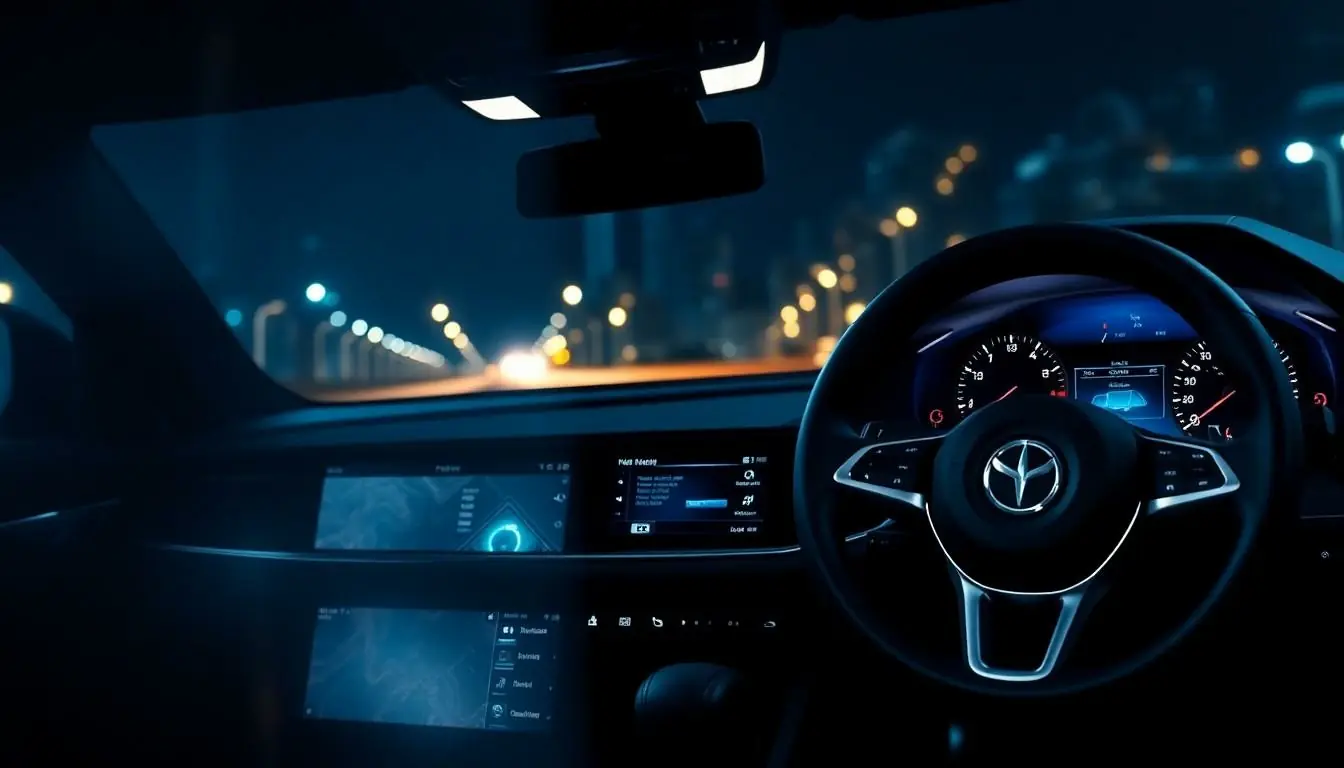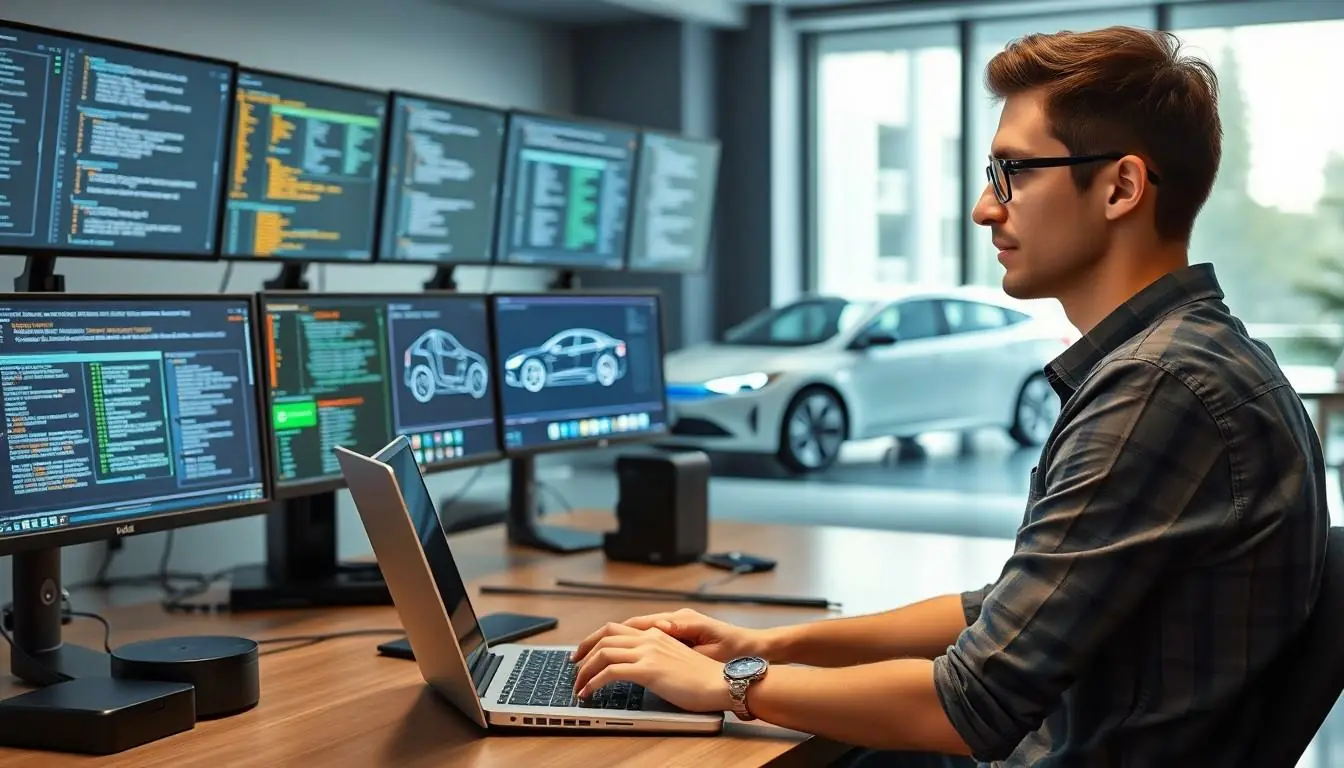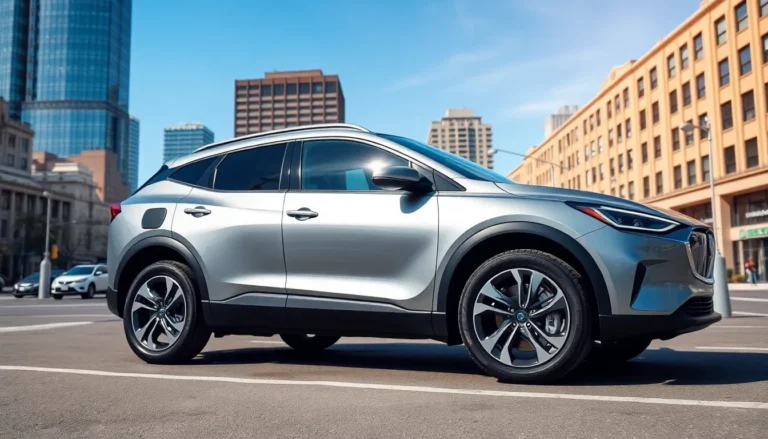In a world where cars are practically smarter than their drivers, software development for the automotive industry isn’t just a trend; it’s an absolute necessity. Picture this: a vehicle that can parallel park itself while you sit back and enjoy your favorite podcast. Sounds like magic? It’s just the power of cutting-edge software at work, transforming how we drive and interact with our vehicles.
As the automotive landscape shifts towards electric and autonomous technologies, the demand for innovative software solutions skyrockets. Developers are now the unsung heroes behind the scenes, crafting the code that makes modern vehicles not only functional but downright impressive. So buckle up and get ready to explore how software is steering the automotive industry into the future, one line of code at a time.
Table of Contents
ToggleOverview of Software Development for Automotive Industry
Software development significantly influences the automotive industry. Advanced technologies become commonplace in vehicles, highlighting the need for robust software solutions. Software drives innovations, such as self-parking and advanced driver-assistance systems (ADAS). Furthermore, these innovations enhance both safety and convenience for drivers.
Electric vehicles (EVs) incorporate extensive software to manage battery systems and optimize performance. Real-time data analysis allows for improved driving experiences and vehicle maintenance. Autonomous driving requires complex algorithms, combining artificial intelligence with machine learning to ensure safe navigation. Developers perform critical functions, programming the systems that support high-performance vehicles.
Integration of software and hardware plays a vital role. Engineers collaborate to create vehicle architecture that supports seamless communication between components. Continuous updates ensure that software can adapt to evolving technologies and user needs. This flexibility is essential in a fast-paced market.
Established automotive companies invest heavily in research and development. They prioritize creating software that aligns with consumer expectations and regulatory standards. New startups also emerge, focusing on niche markets, which drives further innovation in the sector.
Software development for the automotive industry addresses numerous challenges, including cybersecurity concerns. Developers implement stringent security measures to safeguard critical vehicle functions against potential threats. The growing reliance on connectivity increases the importance of developing secure and reliable software solutions.
Software development adapts to the industry’s rapid transformation. Combining cutting-edge technology with user-friendly features positions manufacturers to compete effectively in an ever-evolving landscape.
Key Technologies in Automotive Software Development

Software development in the automotive industry relies on several key technologies driving innovation and efficiency.
Embedded Systems
Embedded systems play a vital role in automotive software development. These systems manage various vehicle functions, including engine control, infotainment, and navigation. They’re designed for real-time operation, ensuring timely responses to inputs like driver actions or environmental changes. Sensors, microcontrollers, and software integration ensure effective performance and reliability. Most modern vehicles depend heavily on embedded software to operate efficiently, boosting safety and user experience.
Autonomous Vehicle Software
Autonomous vehicle software is revolutionizing transportation. It encompasses algorithms for perception, decision-making, and control systems that allow vehicles to navigate without human intervention. Technologies like computer vision and machine learning enhance the vehicle’s ability to interpret surroundings and make informed decisions. Robust testing and validation processes ensure safety and reliability, allowing manufacturers to meet regulatory requirements. As this technology advances, it significantly contributes to the future of mobility, shaping how society views transportation.
Software Development Life Cycle in Automotive
The software development life cycle (SDLC) in the automotive industry consists of several stages that ensure high-quality software solutions. This structured approach meets the industry’s rigorous demands and expectations.
Requirements Gathering
Requirements gathering stands as a crucial initial step in the SDLC. During this phase, developers collaborate with stakeholders to understand specific needs and expectations. They conduct interviews and surveys, helping to define project objectives. Market research provides insights into consumer preferences and regulatory requirements. Documentation then captures these insights, ensuring clarity and direction for subsequent stages. Prioritization of features occurs next, enabling teams to focus on critical aspects. The resulting requirements help set a solid foundation for effective software development.
Design and Implementation
Design and implementation follow requirements gathering, transforming concepts into functional software. In this phase, software architects develop high-level designs, outlining system architecture and user interfaces. Prototyping often occurs, allowing for early feedback and adjustments. Engineers translate designs into code, utilizing programming languages compatible with automotive systems. Continuous integration practices facilitate regular updates, improving software quality. Testing occurs throughout this phase, identifying and addressing defects promptly. These combined efforts lead to robust software solutions that meet the automotive industry’s standards.
Challenges in Automotive Software Development
Automotive software development faces several unique challenges that must be addressed to advance the industry.
Safety and Compliance
Safety ranks as a top priority in automotive software development. Developers must abide by stringent regulations and standards, ensuring products comply with safety protocols set by organizations such as ISO and IEC. Numerous safety features, such as braking systems and airbag deployment, rely on precise software algorithms, making thorough testing and validation critical. Regulatory compliance involves continuous monitoring of changes in laws to maintain adherence throughout the software life cycle. Additionally, meeting the expectations of consumers and stakeholders necessitates prioritizing reliability over innovation in safety-sensitive applications.
Integration with Hardware
Integration with hardware presents another significant challenge. Successful automotive software requires seamless interaction with various physical components, including sensors, processors, and control units. Engineers must design software architectures that accommodate different hardware platforms while enabling efficient communication between them. Real-time operation plays a crucial role, as sensors and software must work in tandem for accurate decision-making. Developers also deal with the complexities of firmware updates to enhance functionality without compromising safety. Organizing collaborative efforts between software and hardware teams ensures optimal performance and enhances overall vehicle reliability.
Future Trends in Automotive Software Development
The automotive industry is poised for significant advancements in software development, driven by the increasing complexity of vehicle systems. One prominent trend focuses on the integration of artificial intelligence (AI) and machine learning (ML), enhancing vehicle capabilities such as predictive maintenance and personalized driving experiences. These technologies analyze vast amounts of data, allowing vehicles to learn from user behavior and optimize performance over time.
Another key trend is the rise of over-the-air (OTA) updates, facilitating timely improvements and new features without requiring physical service visits. By incorporating OTA capabilities, manufacturers can deliver software updates that enhance vehicle security, performance, and functionality seamlessly. This approach minimizes scheduling hassles for consumers while ensuring vehicles stay current with technological advancements.
Enhanced connectivity is also at the forefront, with vehicles increasingly relying on cloud services for real-time data exchange. Improved vehicle-to-everything (V2X) communication not only boosts road safety but also enhances traffic management. Information sharing between vehicles, infrastructure, and even pedestrians drives efficiency, contributing to smarter transportation systems.
The focus on electric vehicles (EVs) and autonomous driving continues to dominate software development efforts. Developers prioritize creating software that optimizes energy consumption and extends battery life, addressing consumer concerns about range anxiety. Meanwhile, sophisticated algorithms that govern autonomous navigation evolve rapidly, allowing vehicles to interpret complex environments and respond safely.
Cybersecurity remains a pressing challenge as connected vehicles become more common. Developers must reinforce security protocols to protect against potential threats. Effective strategies include implementing robust encryption methods, conducting regular vulnerability assessments, and fostering a culture of security awareness within development teams.
Finally, sustainability trends influence software development, prompting developers to create solutions that minimize environmental impact. Designing efficient software that reduces energy consumption and enhances resource management aligns with global sustainability goals, appealing to eco-conscious consumers.
The automotive industry is undergoing a profound transformation driven by innovative software development. As vehicles evolve into more advanced and connected machines, the role of skilled developers becomes increasingly vital. They’re not just creating software; they’re shaping the future of transportation.
With the rise of electric and autonomous vehicles, the demand for sophisticated software solutions continues to grow. This evolution presents both opportunities and challenges, particularly in ensuring safety and compliance. As technology advances, the integration of AI and machine learning will further enhance vehicle capabilities, making driving safer and more efficient.
The automotive sector’s future hinges on seamless collaboration between software and hardware, ensuring that vehicles meet the ever-changing needs of consumers and regulatory standards. Embracing these changes will be essential for companies aiming to thrive in this dynamic landscape.





